Introduction
Grasslands play an important role in global carbon (C) storage, and the po tential to sequester C is quite different among different world’s ecosystems ( López-Fando & Pardo 2011). Grass lands, which are one of the most widely distributed ecosystems on Earth ( Fang et al., 2010), contain a large part of the terrestrial biosphere’s C ( Cheng et al., 2011). Indeed, incorrect grazing management of grasslands may decrease the global C storage both directly and indi rectly ( Li et al., 2013). Minor alterations in grasslands may have outstanding ef fects on C storage ( Deng et al., 2016). In China, the total national land is covered approximately 44% by grasslands, ac counting for about 9-16% of the world’s grassland C storage ( Ni, 2002). As al pine grasslands of the Qinghai-Tibetan Plateau play a key role in the terrestrial carbon cycle ( Zhao et al., 2006), mon tane meadows in the Liaoning Province, China, might also play an important role in C storage. In recent decades, part of the grasslands of Liaoning have been se riously degraded by some environmen tal changes and human activities ( Harris, 2010). Grassland degradation has seriously led to a loss of soil organic C (SOC) in northwest China ( Li et al., 2019). The loss of C has disadvantageous effects on soil nutrients and soil structure, leading to global warming by increasing the C dioxide concentration in the atmosphere ( Xiong et al., 2016). It is critical to restore the degraded grasslands to decrease the environmental problems such as the soil C loss to the atmosphere and subse quent climatic warming ( Paustian et al., 2016). Therefore, large scale fencings to livestock grazing based on the “Self-de sign (Natural Restoration)” theory have turned into a significant way to abate grassland degradation ( Li et al., 2019).
Soil C storage is a function of the balance between the inputs from abo veground and belowground biomasses and the losses because of the decompo sition of these biomasses ( Pendall et al., 2011). Carbon contained in the grass land biomass in the Liaoning Province is an important component of the total regional C budget, and changes in the species composition influence not only the type but also the availability of abo veground C ( Steinbeiss et al., 2008). Car bon storage in the aboveground parts of vegetation is a time-integrated expres sion of processes ranging from photo synthesis and nutrient cycling to distur bance and climate change ( Asner et al., 2012). Belowground biomass C is also a necessary component of the C cycle in grassland ecosystems and an important element in soil C sequestration ( Li et al., 2019). Soil microorganisms can also affect various soil properties, and are responsible for the transformation and cycling of plant nutrients and soil organ ic matter, thus also affecting C seques tration ( Li et al., 2013). Soil microbial biomass carbon can also be significantly affected by land-use practices ( Li et al., 2013). However, the effects of grassland degradation and management strategies are inconsistent and variable on soil C storage, depending on the system. Her bivores, for example, may facilitate or reduce C sequestration rates (He et al., 2011; Silva et al., 2019).
Some researchers have studied soil organic C contents on fenced versus unfenced grasslands in Inner Mongolia, China ( Li et al., 2013). However, relative ly few studies have clearly described the effects of fenced versus unfenced grass lands on C sequestration in the Liaoning Province. We assume that restoration processes occurring on grassland enclo sures (i.e., fencing) to domestic livestock may affect the stocks of C in those grass lands by affecting the carbon contents in the aboveground, belowground and litter biomasses, and in the soil. We hy pothesize that total plant biomass (i.e., aboveground + root + litter), and total plant and soil C storages are greater on fenced than unfenced areas, and differ between counties in the Liaoning Prov ince. The objectives of this study were to determine (1) the effects of grassland fencing on aboveground, root and total plant biomasses; and aboveground, root, total plant and soil C storages at various counties of the Liaoning Province, and (2) determine the relationship between total plant biomass and total plant C storage on fenced and unfenced areas in various counties at Liaoning.
Materials and Methods
Site description
This study was conducted in the Desert ification Governance Base of six coun ties of Liaoning province in China. The six counties were Yixian (YX), Lingyu an (LY), Kazuo (KZ), Jianchang (JC), Beipiao (BP) and Jianping (JP) (41°02’N- 42°16’ N, 119°36’ E-121°23’ E; Figure 1).
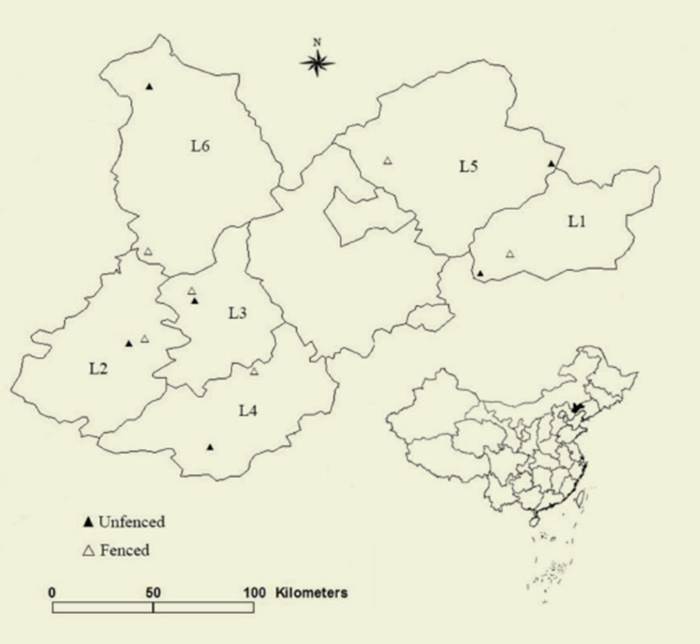
Figure 1: Diagrammatic representation illustrating the location of each of the six studied counties in the Liaoning Province, China. L1= Yixian; L2= Lingyuan; L3= Kazuo; L4=Jian chang; L5= Beipiao; L6= Jianping Figura 1: Diagrama que ilustra las 6 localidades estudiadas en la Provincia de Liaoning, China (L1= Yixian; L2= Lingyuan; L3= Kazuo; L4=Jianchang; L5= Beipiao; L6= Jianping)
The climate is characterized by cool summers and long, cold winters. The mean daily temperature is 20 °C, rang ing from 15 °C to 30 °C in August. Mean annual temperatures were 8.5 °C in Yix ian, 7.1 °C in Lingyuan, 7.2 °C in Kazuo, 7.3 °C in Jianchang, 7.5 °C in Beipiao, and 6.7 °C in Jianping. Mean annual pre cipitations were 562 mm in Yixian, 601 mm in Lingyuan, 561 mm in Kazuo, 610 mm in Jianchang, 475 mm in Beipiao, and 531 mm in Jianping.
The experimental area had been exposed to long-term heavy grazing before 2011. As a result, grasslands were severely degraded, as indicated by their low vegetation cover. Since early 2011, exclosures were established to prevent herbivory grazing at each study county (i.e., fencing). Unfenced areas were used as a control. Further characteristics of the study site are described in Tables 1 and 2.
Table 1: Longitude, Latitude, Altitude, Dominant soil characteristic, Vegetation type and Utili zation method (fenced, unfenced) at each of the studied counties Tabla 1: Longitud, Latitud, Altitud, Característica dominante del suelo, tipo de vegetación y método de utilización (áreas clausuradas o no al acceso de herbívoros domésticos) en cada una de las localidades estudiadas
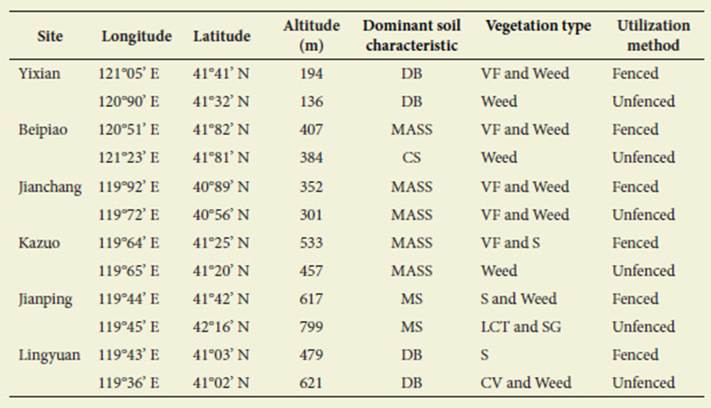
DB is dark brown, MASS is meadow aeolian sandy soil, CS is chestnut soil, MS is meadow soil VF is Vervain Family, CV is Chloris virgata, S is Sedge, LCT is Leymus chinensis Tzvel., SG is Stipa grandis
Table 2: Species composition and total mean cover (%) for each species on fenced and un fenced areas in six counties of the Liaoning Province, China, in early 2011. Each value of total cover for each species was the mean of n=5 Tabla 2: Composición de especies y cobertura total promedio (%) para cada especie en áreas clausuradas o no al acceso de herbívoros domésticos en seis localidades de la Provincia de Liaoning, China, a principios de 2011. Cada valor de cobertura total para cada especie fue el promedio de n=5
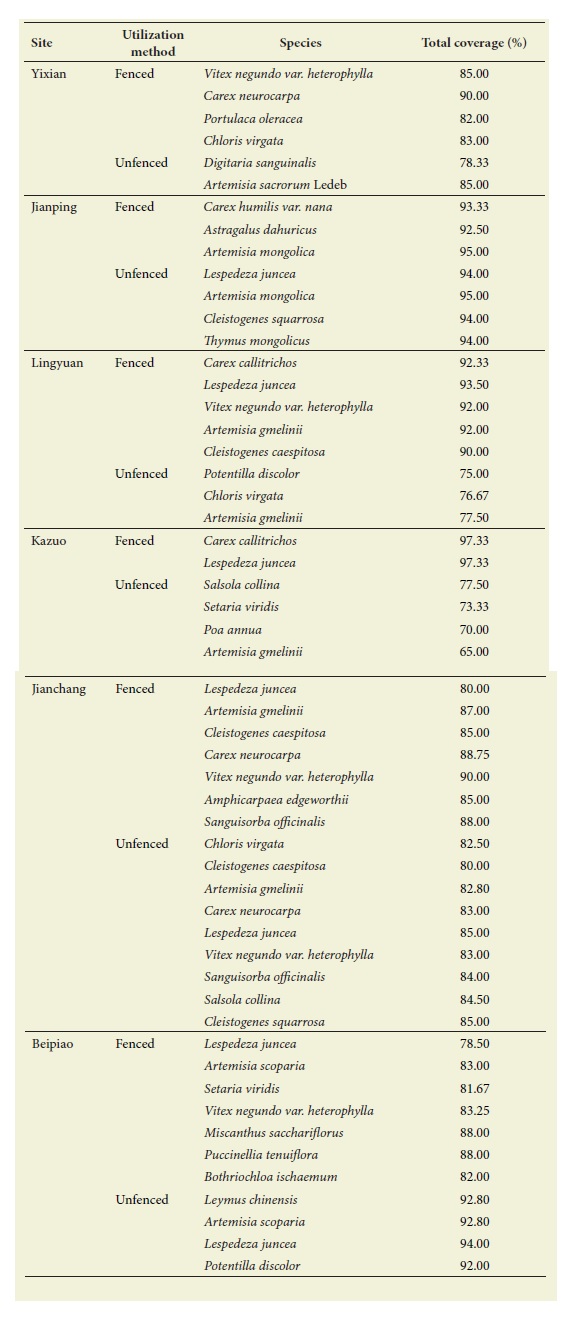
Experimental procedures
At each county, samples were taken with in the exclosures, and were compared to those exposed to all-year-round grazing outside those exclosures. The vegetation was sampled in August (late summer) 2011. At this time of the year, grassland plants reached their peak growth ac cumulation since the beginning of the growing season. In each study area of the same county (i.e., treatments), five 1 × 1 m 2 randomly distributed plots were established. Immediately after plot es tablishment, the soil surface within each plot was cleaned from any residue. After wards, the number of plants was counted, and plant species composition and cover determined within each quadrat during August following Mueller-Dombois & Ellenberg (1974). After this measure ment, we cut all plants to 5 cm height in each quadrat using scissors, and collect ed the plant litter on the soil surface, to measure aboveground biomass following Ma et al. (2002). To measure the below ground biomass, a 9-cm-diameter root auger was used to take one soil sample for each depth range of 0-10 cm, 10-20 cm, and 20-30 cm in each 1 m x 1 m quadrat. The roots found in the soil samples were isolated using a sieve (2 mm, 0,5 mm). All isolated roots as well as the soil were oven dried at 65 °C for 24 h and weighed.
A soil sampling drill of a 5.046-cm-in ner-diameter (S1 Canada) was used to obtain an undisturbed soil core from 0 to 30 cm on each of the five 1 x 1 m quad rats; soil subsamples from 0 to 30 cm in depth were taken every 10 cm. The roots were separated from the soil samples by sieving through a 2 mm mesh screen. The soil samples without roots and de bris were air dried and stored for analyz ing soil physico-chemical characteristics.
For the soil bulk density, a 5.046-cm in ner-diameter soil sampling drill (S1 Cana da) was used to obtain an undisturbed soil core from 0 to 30 cm. Thereafter, the soil bulk density (g cm 3) in the undisturbed soil cores from the fenced and unfenced quad rats was measured by the soil bulk sampler method ( Pennock et al., 2008). After siev ing the soil through a 2-mm-mesh screen to remove roots and other residues, it was oven dried to constant weight at 105 °C.
Soil pH was measured by an acidity agent (PHS-3C pH acidometer, China). Total soil and plant N concentrations were evaluated by the Kjeldahl method ( Bremner, 1996).
Determination of organic C concentrations
After measuring aboveground and root biomasses, plant samples were pulver ized using a ball mill. Concentrations of aboveground plant C (APC), litter C (LC), root C (BRC), and organic soil C (OSC) were all analyzed by the potassi um dichromate oxidation external heat ing method (GB9834-1988).
Formulas
We calculated the Aboveground Plant C Storage (APCS; Mg/ha); Litter C Stor age (LCS; Mg/ha); Total Aboveground C Storage (TACS; Mg/ha); Total Root C Storage (TRCS; Mg/ha); Total Plant C Storage (TPCS; Mg/ha); Total Soil C Storage (TSCS; g/m-2); Total Grassland C Storage (TGCS;Mg/ha) on a per unit area basis up to 30 cm soil depth, and To tal Grassland C Storage(TGCS;Tg) using the following formulas:
TAB=SCB+LB
TRB=ΣRBi (from hi = 1 to 3)
APCS=TAB *APC
LCS =LB * LC
TACS=APCS+LCS
RCSi= RBi * RCi
TRCS=ΣRCSi (from hi = 1 to 3)
TPCS=TACS+TRCS
OSCSi= OSCi * SBSi * hi (from hi = 1 to 3)
TSCS=ΣOSCSi (from hi = 1 to 3)
TGCS= TSCS+TPCS
TGCS= TGCS *S/108
where TAB is total aboveground biomass (g/m 2); SCB is total standing crop bio mass (g/m 2); LB is litter biomass (g/ m 2); TRB is total root biomass (g/ m 2); hi is soil depth (i.e., 1=0-10, 2=10-20, 3=20- 30 cm); RBi is the root biomass of the ith soil layer (g/m -3); APC is aboveground plant C concentration (%); APCS is aboveground plant C storage (Mg/ha); LC is litter C concentration (%); LCS is litter C storage (g/m 2); TACS is total aboveground C storage; RCi is root C concentration of ith soil layer (%); RCSi is root C storage of ith soil layer (Mg/ ha), TRCS is total root C storage (Mg/ ha); TPCS is total plant C storage (Mg/ ha); OSCi is organic soil C concentra tion of ith soil layer (%); SBSi is soil bulk storage of the ith soil layer (g/m -3); OSCSi is organic soil C storage of ith soil layer (Mg/ha); TSCS is total soil C stor age (Mg/ha); TGCD is total grassland C storage per unit surface area (Mg/ha); S is fenced area (ha); TGCS is total grass land C storage (Tg).
Statistical analysis
Treatments were analyzed following a completely randomized design using two-way ANOVA for comparing fencing level (i.e., fenced and unfenced areas) versus counties for various variables, and three-way ANOVA for comparing vari able values at each of the three studied soil depths. When F tests were signifi cant (p < 0.05), differences among means were determined using the LSD test of Fisher ( Snedecor and Cochran, 1980). All statistical analyses were performed using SPSS21.
Results
Soil physicochemical characteristics
There was a significant (p<0.05) inter action between Utilization Method x County for soil bulk density, soil pH, and soil N concentrations. At the same time, the interaction between Utilization Method x County was not significant (p>0.05) for soil C concentrations.
Soil bulk density
Soil bulk density was lower (p<0.05) on fenced than unfenced areas in 3 out of the 6 counties (i.e., Lingyuan, Kazuo and Jianping; Table 3).
Table 3: Soil bulk density (g/cm3), soil pH and soil N concentrations on fenced and unfenced areas at each of the studied counties. There was interaction between Utilization method x Counties for each of the shown soil variables. Each value is the mean of n=5. Different letters to the left of the comma indicate significant differences (p<0.05) between utilization methods within each county, and those to the right of it indicate significant differences (p<0.05) among counties within each utilization method Tabla 3: Densidad de volumen de suelo (g/cm3), pH y concentraciones de N del suelo en áreas clausuradas o no al acceso de herbívoros domésticos en cada una de las localidades estudiadas. Hubo una interacción entre Método de utilización x Localidades para cada una de las variables de suelo mostradas. Cada valor es el promedio de n=5. Letras diferentes a la izquierda de la coma indican diferencias significativas (p<0.05) entre métodos de utilización dentro de cada localidad, y aquellas a la derecha de la coma indican diferencias significativas (p<0.05) entre localidades dentro de cada método de utilización
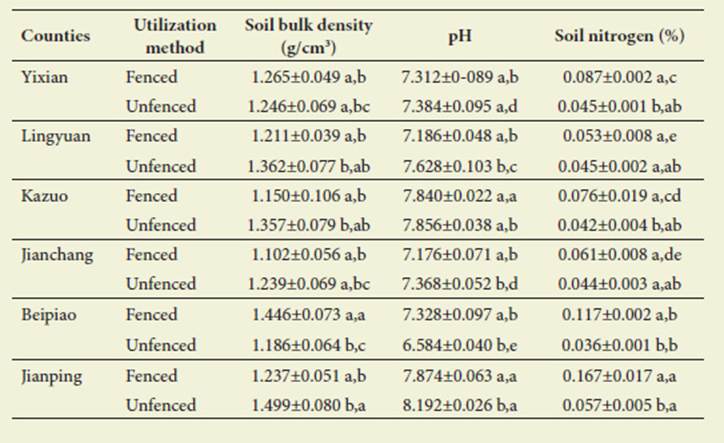
In 2 (i.e., Yixian and Jianchang) out of the 6 counties, soil bulk density was similar (p> 0.05) on fenced and unfenced areas. On fenced areas, Beipiao showed the greatest (p<0.05) soil bulk density in comparison to the other 5 counties. These last counties showed a similar (p>0.05) soil bulk density. The greatest and lowest (p<0.05) soil bulk densities were shown at Jianping and Beipiao, respectively, on unfenced areas.
Soil pH
Jianping and Kazuo showed a similar (P>0.05) but greater (p<0.05) soil pH than the other 4 counties on fenced ar eas ( Table 3). These last counties had a similar (p>0.05) soil pH on those areas. On unfenced areas, soil pH followed the following order from greatest to lowest (p<0.05): Jianping > Kazuo > Lingyuan > Yixian > Jianchang > Beipiao.
Soil N concentrations
Soil N concentrations were greater (p<0.05) on fenced than unfenced ar eas on four (i.e., Yixian, Kazuo, Beipiao, Jianping) out of the six counties ( Ta ble 3). These last counties showed a sim ilar (p>0.05) soil N concentration. The greatest and lowest (p<0<05) soil N con centrations were found in Jianping and Lingyuan, respectively, on fenced areas. At the same time, the greatest and low est (p<0.05) soil N concentrations were shown in Jianping and Beipiao, respec tively, on unfenced areas.
Soil C concentrations
Soil C concentrations were almost twice as great (p<0.05) on fenced than unfenced areas ( Table 4).
Table 4: Soil C concentrations on fenced versus unfenced areas, and among counties in the Liaoning Province. There was not an interaction (p> 0.05) between Utilization method x Counties for the studied variable. Each value is the mean of n=5. Different letters between Uti lization methods indicate significant differences (p<0.05) between fenced and unfenced areas. Different letters among counties indicate significant differences (p<0.05) among them. Tabla 4: Concentraciones de C del suelo en áreas clausuradas versus no clausuradas al acceso de herbívoros domésticos, y entre localidades en la Provincia de Liaoning. No hubo interacción (p>0.05) entre Método de utilización x Localidades para la variable estudiada. Cada valor es el promedio de n=5. Letras diferentes entre métodos de utilización indican diferencias significativas (p<0.05) entre áreas clausuradas o no al acceso de herbívoros domésticos. Letras diferentes entre localidades indican diferencias significativas (p<0.05) entre ellas

In turn, the greatest and lowest (p< 0.05) soil C con centrations were found at Yixian and Ji anping, respectively.
Aboveground, root and total plant biomasses
Standing crop biomass
Fencing level and county showed a sig nificant interaction (p=0.001) for stand ing crop biomass. Standing crop biomass was at least 57% greater on fenced than unfenced areas in all counties ( Figure 2).
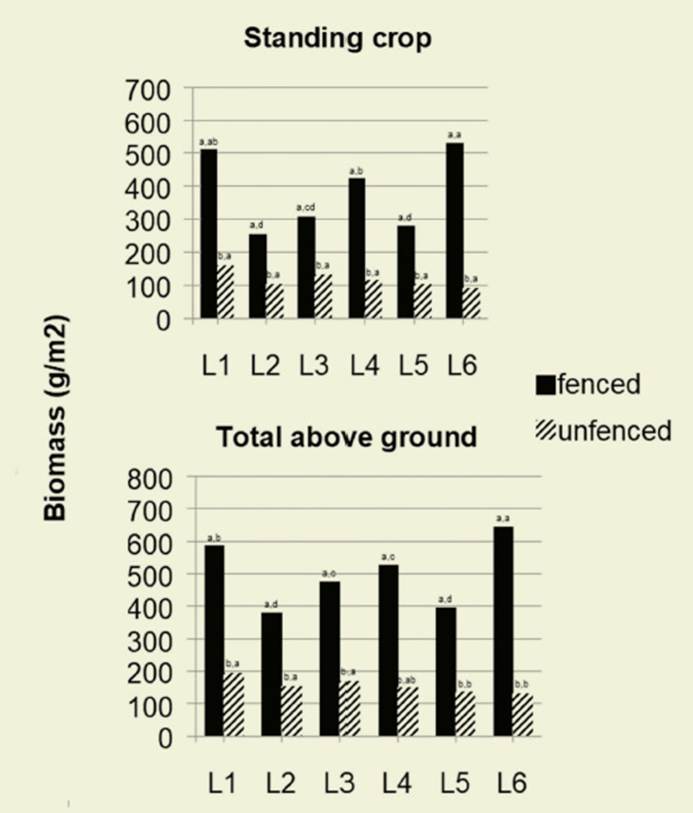
Figure 2: Standing crop and total aboveground (standing crop + litter) plant biomasses (g/ m 2) at six counties (L1= Yixian, L2= Lingyuan, L3= Kazuo, L4= Jianchang, L5= Beipiao and L6= Jianping) in the Liaoning Province, northeastern China. Each histogram is the mean of n=5. Different letters to the left above the histograms indicate significant differences (p<0.05) between fenced and unfenced sites within each county, and those to the right of them indicate significant differences (p<0.05) among the studied counties within each fencing level. Figura 2: Biomasas de las plantas en pie y total aéreas (biomasa en pie + broza) (g/m 2) en seis localidades (L1= Yixian, L2= Lingyuan, L3= Kazuo, L4= Jianchang, L5= Beipiao y L6= Jianping) en la Provincia de Liaoning al noreste de China. Cada histograma es el promedio de n=5. Letras diferentes a la izquierda encima de los histogramas indican diferencias significativas (p<0.05) entre áreas clausuradas o no al acceso de herbívoros domésticos dentro de cada localidad, y aquellas a la derecha de la coma indican diferencias significativas (p<0.05) entre las localidades estudiadas dentro de cada nivel de clausura
The greatest (p<0.05) standing crop bio masses on fenced areas were found at Yixian and Lingyuan, while those low est (p<0.05) were shown at Beipiao, Ji anchang and Jianping. There were not significant differences (p>0.05) among counties on standing crop biomasses on unfenced areas.
Aboveground litter biomass [3]
The interaction between fencing level and county was not significant (p=0.229) for litter biomass. Litter biomass was 66% greater (p<0.05) at fenced (116.7 g/m 2) than unfenced (39.1 g/m 2) ar eas. However, all counties had a similar (p=0.130) litter biomass.
Total aboveground biomass
The interaction between fencing level and county was significant (p=0.013) for total aboveground (standing crop + litter) biomass. Total aboveground biomasses were more than 59% greater (p<0.05) on fenced than unfenced areas at all counties ( Figure 2). The greatest and lowest (p<0.05) total aboveground biomasses were found at Lingyuan, and Beipiao and Jianping, respectively, on fenced areas. On unfenced sites, total aboveground biomasses were greater (p<0.05) at Xixian, Lingyuan and Kazuo than at Beipiao and Jiangping.
Root biomass
All interactions between fencing level and locality, soil depth x county and soil depth x fencing level were significant at p=0.000. Root biomasses were at least 77% greater (p<0.05) on fenced than un fenced sites at all locations but Lingyuan ( Figure 3).
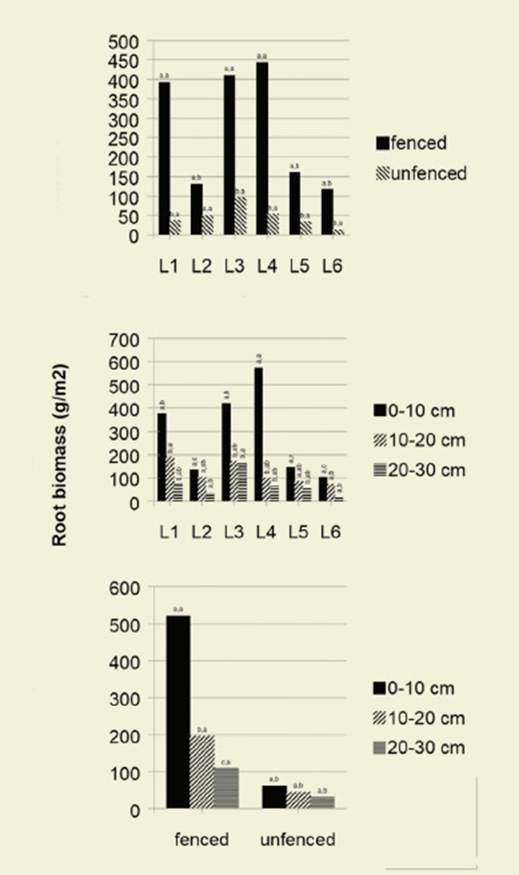
Figure 3: Root biomass (g/m 2) at (1) fenced and unfenced sites on each of the studied coun ties in the Liaoning Province, northeastern China (L1= Yixian, L2= Lingyuan, L3= Kazuo, L4= Jianchang, L5= Beipiao and L6= Jianping); (2) 0-10, 10-20 or 20-30 cm soil depth from the soil surface within each of the studied counties; (3) 0-10, 10-20 or 20-30 cm soil depth from the soil surface within each fenc ing level. Each histogram is the mean of n=5. Different letters to the left above the histograms indicate significant differences (p<0.05) between (1) fenced and unfenced sites within each county, and those to the right of them indicate significant differences (p<0.05) among the studied counties within each fencing level; (2) different soil depths (0-10, 10-20 or 20-30 cm from the soil surface) within each studied county, and those to the right indicate significant differences (p<0.05) among the counties within each studied soil depth; (3) between soil depths (0- 10, 10-20 or 20-30 cm from the soil surface) within each fencing level, and those to the right of them indicate significant differences (p<0.05) between fenced and unfenced sites within each study soil depth. Figura 3: Biomasa radical (g/m 2) en (1) áreas clausuradas o no al acceso de herbívoros domésticos en seis localidades de la Provincia de Liaoning, al noreste de China (L1= Yixian, L2= Lingyuan, L3= Kazuo, L4= Jianchang, L5= Beipiao y L6= Jianping); (2) 0-10, 10-20 o 20-30 cm de profundidad del suelo desde la superficie del mismo en cada una de las localidades estudiadas; (3) 0-10, 10-20 o 20-30 cm de profundidad del suelo desde la superficie del mismo dentro de cada nivel de clausura. Cada histograma es el promedio de n=5. Letras diferentes a la izquierda de la coma encima de los histogramas indican diferencias significativas (p<0,05) entre (1) áreas clausuradas o no dentro de cada localidad, y aquellas a la derecha de la coma indican diferencias significativas (p<0.05) entre las localidades estudiadas dentro de cada nivel de clausura; (2) diferentes profundidades del suelo (0-10, 10-20 o 20-30 cm desde la superficie del mismo) dentro de cada localidad estudiada, y aquellas a la derecha de la coma indican diferencias significativas (p<0.05) entre las localidades dentro de cada profundidad del suelo estudiada; (3) entre las profundidades del suelo (0-10, 10-20 o 20-30 cm desde la superficie del suelo) dentro de cada nivel de clausura, y aquellas a la derecha de la coma indican diferencias significativas (p<0.05) entre áreas clausuradas o no dentro de cada profundidad del suelo estudiada
Root biomasses were similar (p>0.05) at Yixian, Kazuo and Jianchang on fenced areas. These biomasses, how ever, were greater (p<0.05) than those found at Lingyuan, Beipiao and Jianping, which did not differ (p>0.05) among them at those sites. There were no differ ences (p>0.05) on root biomasses among counties on unfenced areas.
Root biomasses were greater (p<0.05) at 0-10 than 20-30 cm soil depth at all locations but Lingyuan and Jianpiang. At these locations, there were not sig nificant differences (p>0.05) among soil depths in root biomass. The greatest (p<0.05) root biomass at 0-10 cm soil depth was found at Jianchang. At this soil depth, the lowest (p<0.05) root bio masses were found at Lingyuan, Beipiao and Jianping. Yixian, Lingyuan, Kazuo, Jianchang and Beipiao showed a similar (p>0.05) root biomass at 10-20 cm soil depth. However, root biomass at this soil depth was greater (p<0.05) at Yixian than at Jianping. At 20-30 cm soil depth, root biomass was greater (p<0.05) at Yix ian, Kazuo, Jianchiang and Beipiao than at Lingyuan and Jianping.
On fenced sites, the highest (p<0.05) and lowest (p<0.05) root biomasses oc curred at 0-10 and 20-30 cm soil depths, respectively. Unfenced sites, however, showed a similar (p>0.05) root biomass at all study soil depths. At 0-10, 10-20 and 20-30 cm soil depths, root biomasses were greater (p<0.05) on fenced than unfenced sites. While root biomasses were above 100 g/m 2 on fenced sites at all study soil depths, they were below 64 g/m 2 on un fenced sites at these same soil depths.
Total root biomass
There was an interaction (p=0-000) between county and fencing level for total root biomass. Total root biomass was more than 76% greater (p<0.05) on fenced than unfences sites at all counties, but Lingyuan ( Figure 4).
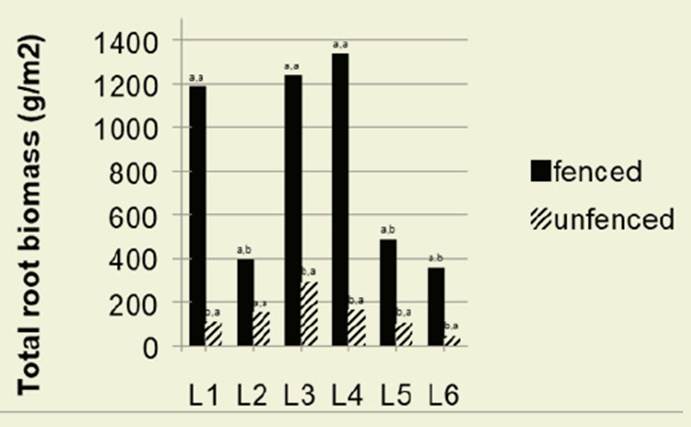
Figure 4: Total root biomass (g/m 2) on fenced and unfenced sites at the various studied coun ties (L1= Yixian, L2= Lingyuan, L3= Kazuo, L4= Jianchang, L5= Beipiao and L6= Jianping) in the Province of Liagoning, China. Each histogram is the mean of n=5. Different letters to the left above the histograms indicate significant differences (p<0.05) between fenced and un fenced sites within each county, and those to the right of them indicate significant differences (p<0.05) among the studied counties within each fencing level. Figura 4: Biomasa radical total (g/m 2) en áreas clausuradas o no al acceso de herbívoros domésticos en seis localidades de la Provincia de Liaoning, China (L1= Yixian, L2= Lingyuan, L3= Kazuo, L4= Jianchang, L5= Beipiao y L6= Jianping) Cada histograma es el promedio de n =5. Letras diferentes a la izquierda encima de los histogramas indican diferencias significativas (p<0.05) entre áreas clausuradas o no dentro de cada localidad, y aquellas a la derecha de la coma indican diferencias siganificativas (p<0.05) entre las localidades estudiadas dentro de cada nivel de clausura
While total root biomass was greater (p<0.05) at Yixian, Kazuo and Jianchang than at Lingyuan, Beipiao and Jianping on fenced sites, all counties showed a similar (p>0.05) total root biomass on unfenced ones.
Total plant biomass
The interaction between fencing and county was significant (p=0.000). Total plant biomass was greater (p<0.05) on fenced than unfenced sites at all coun ties ( Figure 5).
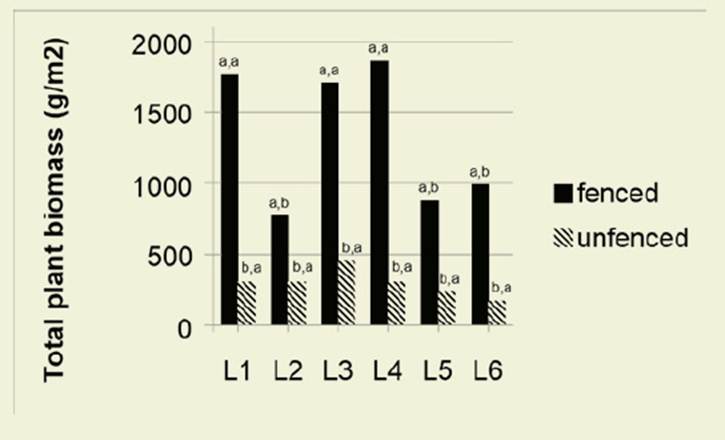
Figure 5: Total plant biomasses (g/m 2) on fenced and unfenced sites at each of the studied counties. (L1= Yixian, L2= Lingyuan, L3= Kazuo, L4= Jianchang, L5= Beipiao and L6= Jian ping) in the Province of Liagoning, China. Different letters at the left above of the histograms indicate significant differences (p<0.05) between fencing levels within each of the studied counties, and those to the right of them indicate significant differences (p<0.05) among the studied counties within each fencing level. Figura 5: Biomasas totales de las plantas (g/m 2) en áreas clausuradas o no al acceso de herbívoros domésticos en cada una de las seis localidades de la Provincia de Liaoning, China (L1= Yixian, L2= Lingyuan, L3= Kazuo, L4= Jianchang, L5= Beipiao y L6= Jianping). Letras diferentes a la izquierda encima de los histogramas indican diferencias significativas (p<0.05) entre áreas clausuradas o no al acceso de herbívoros domésticos dentro de cada una de las localidades estudiadas, y aquellas a la derecha de la coma indican diferencias significativas (p<0.05) entre las localidades estudiadas dentro de cada nivel de clausura
Yixian, Kazuo and Jian chang had a similar (p>0.05) total plant biomass on fenced sites. These biomass es were greater (p<0.05) than those at Lingyuan, Beipiao and Jianping at these sites. On unfenced sites, however, there were no significant differences on total plant biomass among counties on un fenced sites.
Aboveground, root, total plant, soil and grassland C storage
Standing crop C storage
There was an interaction between coun ties and fencing level for standing crop C storage (p=0.004). Fenced sites showed a greater (p<0.05) standing crop C stor age than unfenced ones at all counties ( Figure 6).
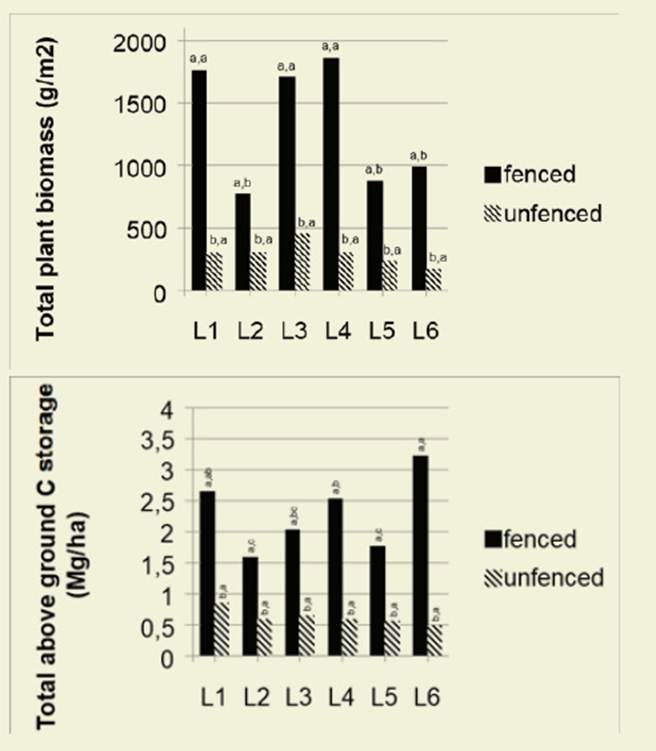
Figure 6: ( (1) Standing crop C storage (Mg/ha) and (2) Total aboveground C storage (Mg/ha) on fenced and unfenced sites on each of the studied counties (L1= Yixian, L2= Lingyuan, L3= Kazuo, L4= Jianchang, L5= Beipiao and L6= Jianping) in the Province of Liagoning, China. Each histogram is the mean of n=5. Different letters to the left above the histograms indicate significant differences (p<0.05) between fenced and unfenced sites within each county, and those to the right of them indicate significant differences(p<0.05) among counties within each fencing level. Figura 6: 1) Almacenamiento de C en las plantas en pie (Mg/ha) y (2) Almacenamiento de C en la parte áera total (Mg/ha) en áreas clausuradas o no al acceso de herbívoros domésticos en cada una de las seis localidades estudiadas en la Provincia de Liaoning, China (L1= Yixian, L2= Lingyuan, L3= Kazuo, L4= Jianchang, L5= Beipiao y L6= Jianping). Cada histograma es el promedio de n=5. Letras diferentes a la izquierda encima de los histogramas indican diferencias significativas (p<0.05) entre áreas clausuradas o no al acceso de herbívoros domésticos dentro de cada localidad, y aquellas a la derecha de la coma indican diferencias significativas (p<0.05) entre localidades dentro de cada nival de clausura
Standing crop C storage was similar (p>0.05) at Yixian, Jianchang and Jianping on fenced sites. These stand ing crop C storage on fenced sites were greater (p<0.05) than those at Lingyuan, Kazuo and Beipiao, which did not show significant differences among them. Unfenced sites, however, did not show significant differences (p>0.05) among counties.
Aboveground litter C storage
There was not a significant interaction (p= 0.203) between counties and fencing levels for litter C storage. However, litter C storage was more than 75% greater (p<0.05) at fenced than unfenced sites (data not shown). On the other hand, lit ter C storage was similar (p>0.05) at all counties (mean= 0.28 Mg/ha; data not shown).
Total aboveground C storage
The interaction between locations and fencing levels was significant (p=0.008) for total aboveground C storage (Fig ure 6). Total aboveground C storage was greater (p<0.05) on fenced than un fenced sites at all counties. On fenced sites, the greatest and lowest (p<0.05) total aboveground C storage were found at Jianping, and Lingyuan and Beipiao, respectively. Yixian, Kazuo and Jian chang, however, showed a similar to tal aboveground C storage on fenced sites. Unfenced sites showed a similar (p>0.05) total aboveground C storage at all counties.
Root C storage
There was an interaction (p<0.05) be tween counties and fencing levels, counties and soil depths, and fencing levels and soil depths for root C storage ( Figure 7).
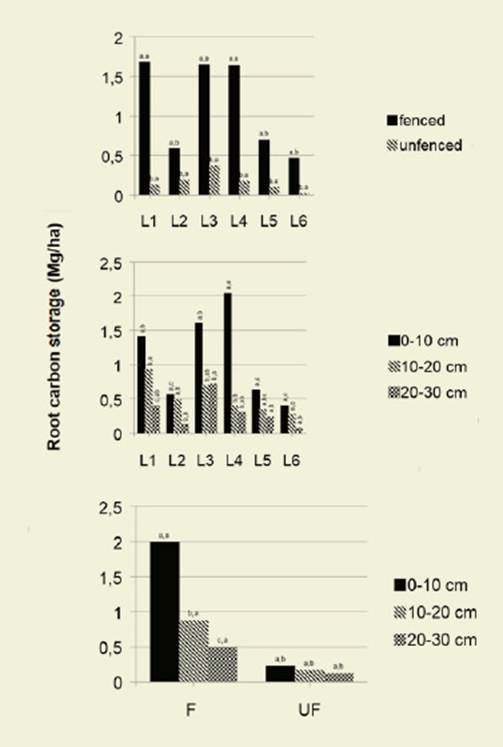
Figure 7: Root carbon storage (Mg/ha) at (1) fenced and un fenced sites on each of the studied counties in the Liaoning Province, northeastern China (L1= Yixian, L2= Lingyuan, L3= Kazuo, L4= Jianchang, L5= Beipiao and L6= Jianping); (2) 0-10, 10-20 or 20-30 cm soil depth from the soil surface within each of the studied counties; (3) 0-10, 10-20 or 20-30 cm soil depth from the soil surface within each fencing level. Each histogram is the mean of n=5. Different letters to the left above the histograms indicate significant differences (p<0.05) between (1) fenced and unfenced sites within each county, and those to the right of them indi cate significant differences (p<0.05) among the studied counties within each fencing level; (2) different soil depths (0-10, 10-20 or 20-30 cm from the soil surface) within each studied county, and those to the right of them indicate significant differences (p<0.05) among the counties within each studied soil depth; (3) different soil depths (0- 10, 10-20 or 20-30 cm from the soil surface) within each fencing level, and those to the right of them indicate significant differences (p<0.05) between fenced and unfenced sites within each study soil depth. Figura 7: Almacenamiento de C en el sistema radical (Mg/ha) en (1) áreas clausuradas o no al acceso de herbívoros domésticos en cada una de las localidades estudiadas en la Provincia de Liaoning al noreste de China (L1= Yixian, L2= Lingyuan, L3= Kazuo, L4= Jianchang, L5= Beipiao y L6= Jianping); (2) 0-10, 10-20 o 20-30 cm de profundidad del suelo desde la superficie del mismo dentro de cada una de las localidades estudiadas; (3) 0-10, 10-20 o 20-30 cm de profundidad del suelo desde la superficie del mismo dentro de cada nivel de clausura. Cada histograma es el promedio de n=5. Letras diferentes a la izquierda encima de los histogramas indican diferencias significativas (p<0.05) entre (1) áreas clausuradas o no al acceso de herbívoros domésticos dentro de cada localidad, y aquellas a la derecha de la coma indican diferencias significativas (p<0.05) entre las localidades estudiadas dentro de cada nivel de clausura; (2) diferentes profundidades del suelo desde la superficie del mismo (0-10, 10-20 o 20- 30 cm) dentro de cada localidad estudiada, y aquellas a la derecha de la coma indican diferencias significativas (p<0.05) entre las localidades dentro de cada una de las profundidades del suelo estudiadas; (3) diferentes profundidades del suelo (0-10, 10-20 o 20-30 cm desde la superficie del mismo) dentro de cada nivel de clausura, y aquellas a la derecha de la coma indican diferencias significativas (p<0.05) entre áreas clausuradas o no al acceso de herbívoros domésticos dentro de cada profundidad del suelo estudiada
Root C storage was greater (p<0.05) on fenced than unfenced sites at all counties. On fenced sites, root C storage was similar (p>0.05) at Yixian, Kazuo and Jianchang. These values, how ever, were greater (p<0.05) than those found at Lingyuan, Beipiao and Jianping on fenced sites. At these sites, Lingyuan, Beipiao and Jianping showed a similar (p>0.05) root C storage. Root C storage was similar (p>0.05) at all locations on unfenced sites.
There was a decreasing (p<0.05) root C storage with increasing soil depth at Yixian. At Lingyuan, root C storage was similar (p>0.05) at 0-10 and 10-20 cm soil depth. These values, however, were greater (p<0.05) than those found at 20-30 cm soil depth at this location. At Kazuo and Jianchang, root C storage was greater (p<0.05) at 0-10 than at 10-20 and 20-30 cm soil depths. Finally, there were no significant differences (p>0.05) in root C storage among soil depths at Beipiao and Jianping.
While root C storage decreased (p<0.05) with increasing soil depth on fenced sites, there were no significant differences (p>0.05) in root C storage among soil depths on unfenced sites. At all soil depths, root C storage was greater (p<0.05) on fenced than unfenced sites.
The interaction between fencing lev el and county was significant (p=0,000) for total root C storage ( Figure 8).
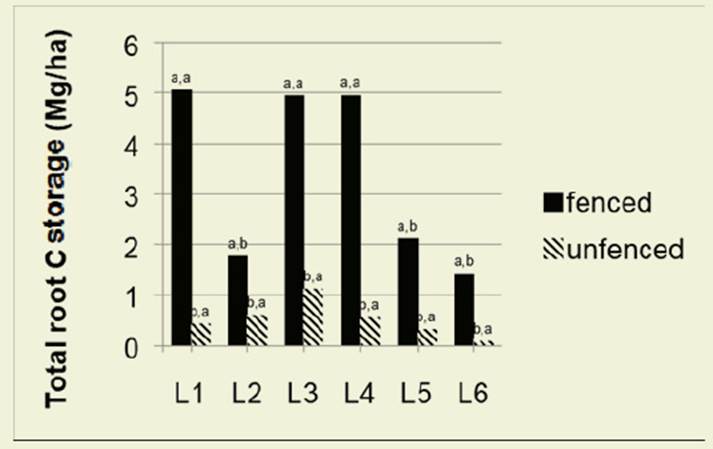
Figure 8: Total root C storage (Mg/ha) on fenced and unfenced sites at the various studied counties (L1= Yixian, L2= Lingyuan, L3= Kazuo, L4= Jianchang, L5= Beipiao and L6= Jian ping) in the Province of Liagoning, China. Each histogram is the mean of n=5. Different letters to the left above the histograms indicate significant differences (p<0.05) between fenced and unfenced sites within each county, and those to the right of them indicate significant differenc es (p<0.05) among the studied counties within each fencing level. Figura 8: Almacenamiento de C en el sistema radical total (Mg/ha) en áreas clausuradas o no al acceso de herbívoros domésticos en seis localidades de la Provincia de Liaoning, China (L1= Yixian, L2= Lingyuan, L3= Kazuo, L4= Jianchang, L5= Beipiao y L6= Jianping). Cada histograma es el promedio de n=5. Letras diferentes a la izquierda encima de los histogramas indican diferencias significativas (p<0.05) entre sitios clausurados o no al acceso de herbívoros domésticos dentro de cada localidad, y aquellos a la derecha de la coma indican diferencias significativas (p<0.05) entre las localidades estudiadas dentro de cada nivel de clausura
Total root C storage was greater (p<0.05) on fenced than unfenced sites on all loca tions. Yixian, Kazuo and Jianchang had a similar (p>0.05) total root C storage on fenced sites. These values were greater (p<0.05) than those found at Lingyuan, Beipiao and Jianping at these sites. These later locations, however, showed a similar (p>0.05) total root C storage on fenced sites. Total root C storage was similar (p>0.05) at all locations on unfenced sites.
Total plant C storage
Fenced sites showed a greater (p<0.05) total plant C storage (i.e., total abo veground + root C storage) than un fenced ones ( Figure 9).
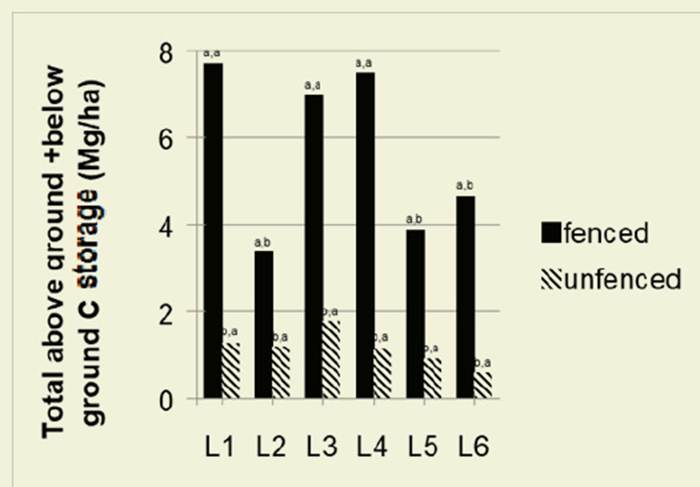
Figure 9: Total plant C storage (Mg/ha) on fenced and unfenced sites at each of the studied counties (L1= Yixian, L2= Lingyuan, L3= Kazuo, L4= Jianchang, L5= Beipiao and L6= Jian ping) in the Province of Liagoning, China. Different letters at the left above of the histograms indicate significant differences (p<0.05) between fencing levels within each of the studied counties, and those to the right of them indicate significant differences (p<0.05) among the studied counties within each fencing level. Figura 9: Almacenamiento de C en toda la planta (Mg/ha) en áreas clausuradas o no al acceso de herbívoros domésticos en cada una de las localidades estudiadas (L1= Yixian, L2= Lingyuan, L3= Kazuo, L4= Jianchang, L5= Beipiao y L6= Jianping) en la Provincia de Liaoning, China. Letras diferentes a la izquierda encima de los histogramas indican diferencias significativas (p<0.05) entre áreas clausuradas o no al acceso de herbívoros domésticos dentro de cada una de las localidades estudiadas, y aquellas a la derecha de la coma indican diferencias significativas (p<0.05) entre las localidades estudiadas dentro de cada nivel de clausura
While total plant C storage was similar (p>0.05) at Yixian, Kazuo and Jianchang, these values were greater (p<0.05) than those shown at Lingyuan, Beipiao and Jianping. Howev er, these latter locations showed a simi lar (p<0.05) total plant C storage. On the other hand, unfenced sites showed a similar (p>0.05) total plant C storage at all locations.
Soil C storage
The interactions between county and fencing level (p=0.033) and county and soil depth (p=0.006) were significant for soil C storage. However, the interaction between fencing level and soil depth was not significant (p=0.448). Soil C storage was greater on fenced than unfenced sites at all counties ( Figure 10).
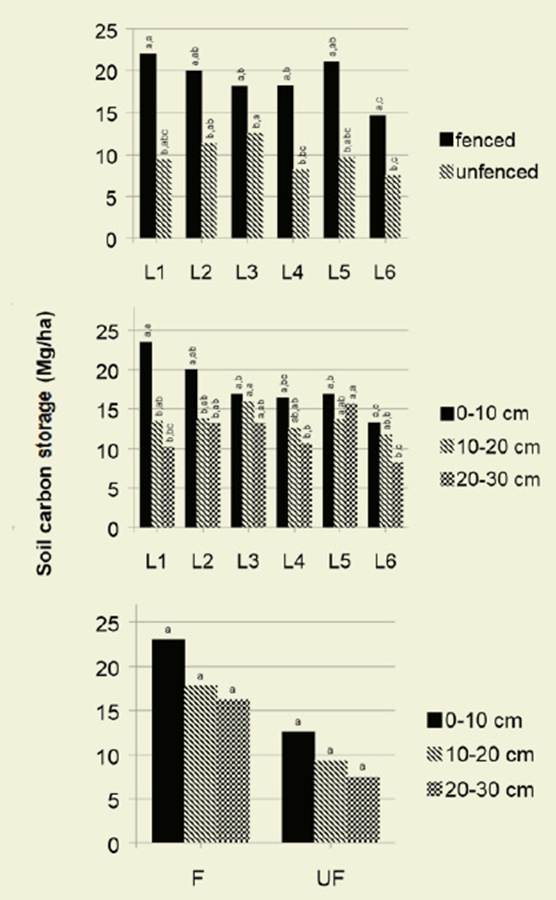
Figure 10: Soil carbon storage (Mg/ha) at (1) fenced and unfenced sites on each of the studied counties in the Liaoning Province, northeast ern China (L1= Yixian, L2= Lingyuan, L3= Kazuo, L4= Jianchang, L5= Beipiao and L6= Jianping); (2) 0-10, 10-20 or 20-30 cm soil depth from the soil surface within each of the studied counties; (3) Each histogram is the mean of n=5. Different letters to the left above the histograms indicate significant differences (p<0.05) between (1) fenced and unfenced sites within each county, and those to the right of them indicate significant differences (p<0.05) among the studied counties within each fencing level; (2) different soil depths (0-10, 10-20 or 20-30 cm from the soil surface) within each studied county, and those to the right indicate significant differences (p<0.05) among the counties within each studied soil depth; (3) fenced and unfenced sites within each study soil depth (0-10, 10-20 or 20-30 cm from the soil surface). Figura 10: Almacenamiento de C en el suelo (Mg/ha) en (1) áreas clausuradas o no al acceso de herbívoros domésticos en cada una de las seis localidades de la Provincia de Liaoning al noreste de China (L1= Yixian, L2= Lingyuan, L3= Kazuo, L4= Jianchang, L5= Beipiao y L6= Jianping); (2) 0-10, 10-20 o 20-30 cm de profundidad del suelo desde la superficie del mismo dentro de cada una de las localidades estudiadas; (3) entre áreas clausuradas o no al acceso de herbívoros domésticos dentro de cada profundidad del suelo estudiada (0-10, 10-20 o 20-30 cm desde la superficie del suelo). Cada histograma es el promedio de n=5. Letras diferentes a la izquierda encima de los histogramas indican diferencias significativas (p<0.05) entre (1) áreas clausuradas o no al acceso de herbívoros domésticos dentro de cada localidad, y aquellas a la derecha de la coma indican diferencias significativas (p<0.05) entre las localidades estudiadas dentro de cada nivel de clausura; (2) diferentes profundidades del suelo (0-10, 10-20 o 20-30 cm desde la superficie del mismo) dentro de cada localidad estudiada, y aquellas a la derecha de la coma indican diferencias significativas (p<0.05) entre las localidades dentro de cada profundidad del suelo estudiada; (3) entre áreas clausuradas o no al acceso de herbívoros domésticos dentro de cada profundidad del suelo estudiada (0-10, 10-20 o 20-30 cm desde la superficie del mismo)
Soil C storage was greater (p<0.05) at Yixian than at Kazuo, Jianchang, and Jianping on fenced sites. Lingyuan and Beipiao showed similar (p>0.05) soil C storage on fenced sites. The lowest (p<0.05) soil C storage on fenced sites was found at Jianping. Yixian, Lingyuan, Kazuo and Beipiao showed similar (p>0.05) soil C storage at unfenced sites. Even more, Yixian, Lingyuan, Jianchang and Beipiao did not differ (p>0.05) in soil C storage on unfenced sites. Finally, Yixian, Jian chang, Beipiao and Jianping also did not show significant differences (p>0.05) on unfenced sites in soil C storage.
Kazuo and Beipiao did not show sig nificant differences (p>0.05) in soil C storage among soil depths. However, Yixian, Lingyuan, Jianchang and Jian ping showed a greater (p<0.05) soil C storage at 0-10 than 20-30 cm soil depths. Nevertheless, soil C storage was simi lar (p>0.05) at 10-20 and 20-30 cm soil depths at Yixian, Lingyuan, Jianchang and Jianping. The greatest and lowest (p<0.05) soil C storageat 0-10 cm soil depth occurred at Yixian and Lingyuan, and Jianping, respectively. At the same time, Lingyuan, Kazuo, Jianchang and Beipiao showed a similar (p>0.05) soil C storage at 0-10 cm soil depth. Yix ian, Lingyuan, Kazuo, Jianchang and Beipiao showed a similar (p>0.05) soil C storage at 10-20 cm soil depth. At this depth, however, soil C storage was great er (p<0.05) at Kazuo than at Jianping. At 20-30 cm soil depth, soil C storage was greater (p<0.05) at Beipiao than at Jian chang, and it was also greater (p<0.05) at Jianchang than at Jianping. However, soil C storage was similar (p>0.05) at Yixiao, Lingyuan, Kazuo and Jianchang at 20-30 cm soil depth ( Figure 10). Finally, Yixian and Jianping did not differ (p>0.05) in the soil C storage at 20-30 cm soil depth.
There were no differences (p>0.05) in soil C storage among the three studied soil depths on fenced and unfenced sites. Also, soil C storage was similar (p>0.05) between fenced and unfenced sites at each of the studied soil depths.
The interaction between fencing level and county was not significant (p=0.170) for total soil C storage. However, there were significant differences for each of the main effects (fencing level, p=0.000; counties, p= 0.010). Fenced sites had a greater (p<0.05) total soil C storage than unfenced ones ( Figure 11).
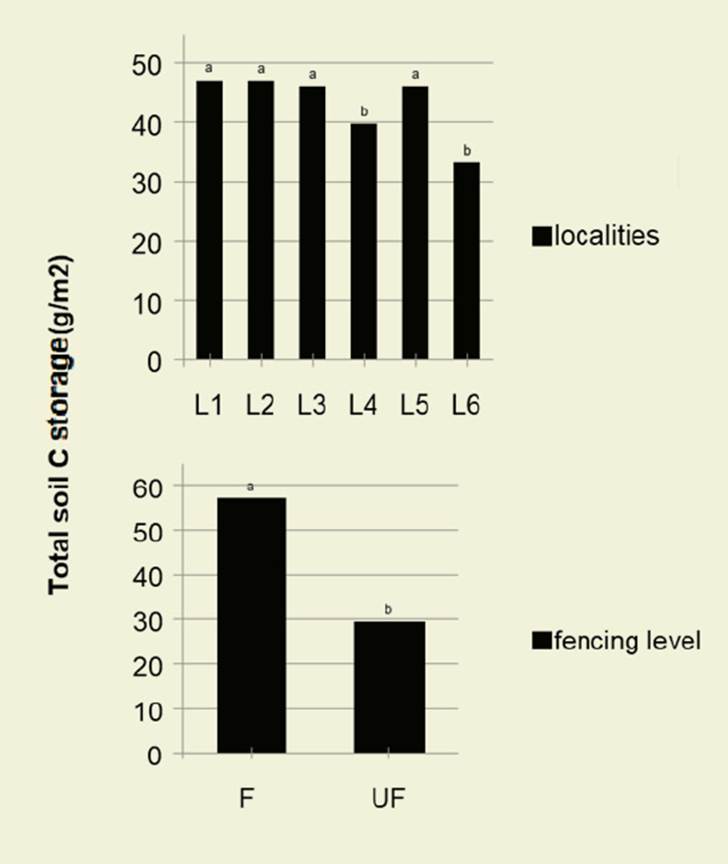
Figure 11: Total soil C storage (Mg/ha) (1) among counties in the Liaoning Province, north eastern China (L1= Yixian, L2= Lingyuan, L3= Kazuo, L4= Jianchang, L5= Beipiao and L6= Jianping), and (2) between fenced (F) and unfenced sites (UF) on average for all study counties. Figura 11: Almacenamento de C total en el suelo (Mg/ha) (1) entre localidades en la Provincia de Liaoning, al noreste de China (L1= Yixian, L2= Lingyuan, L3= Kazuo, L4= Jianchang, L5= Beipiao y L6= Jianping), y (2) entre áreas clausuradas (F) o no (UF) en promedio para todas las localidades estudiadas
Yixian, Lingyuan, Kazuo and Jianchang showed a greater (p<0.05) total soil C storage than Jianchang and Jianping. At the same time, these two later counties showed a similar (p>0.05) total soil Cstorage.
Total grassland C storage
The interaction between fencing level and county was not significant (p>0.05). Nevertheless, there were significant differences between fencing levels and among counties (p<0.05). Total grass land C storage was similar (p>0.05) at Yixian, Lingyuan, Kazuo, Jianchang and Beipiao ( Figure 12).
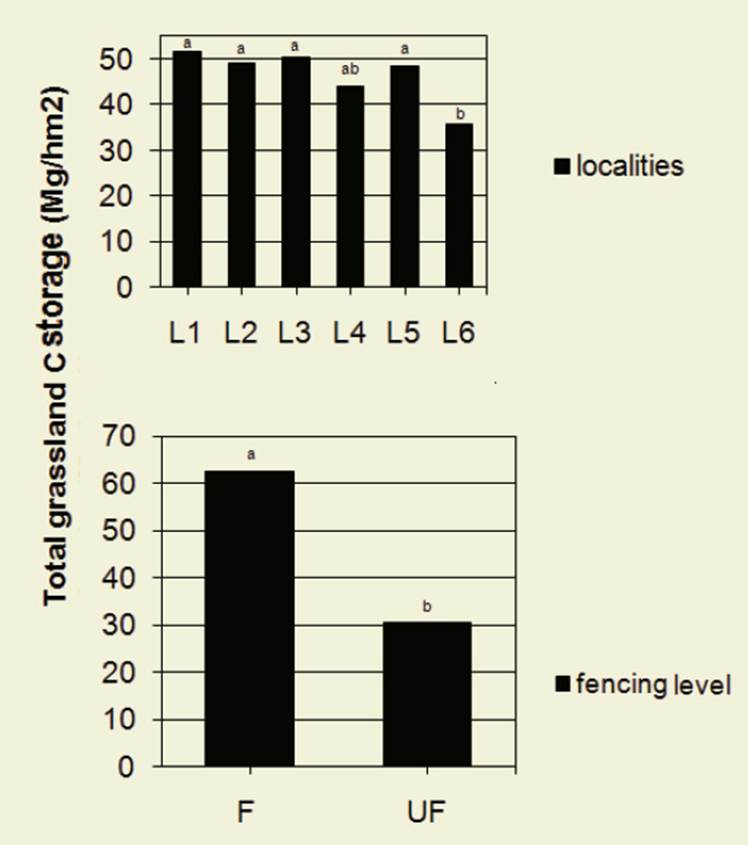
Figure 12: Total grassland C storage (Mg/ha) among counties in the Liaoning Province, north eastern China (L1= Yixian, L2= Lingyuan, L3= Kazuo, L4= Jianchang, L5= Beipiao and L6= Jianping) or fencing levels on average for all counties. Each histogram is the mean of n=5. Dif ferent letters above the histograms indicate significant differences (p<0.05) (1) among counties on average for fenced and unfenced sites, and (2) between fenced (F) and unfenced (UF) sites on average for all counties. Figura 12: Almacenamiento de C total en el pastizal natural (Mg/ha) entre localidades en la Provincia de Liaoning, al noreste de China (L1= Yixian, L2= Lingyuan, L3= Kazuo, L4= Jianchang, L5= Beipiao y L6= Jianping) o niveles de clausura en promedio para todas las localidades. Cada histograma es el promedio de n=5. Letras diferentes encima de los histogramas indican diferencias significativas (p<0.05) (1) entre localidades en promedio para áreas clausuradas o no al acceso de herbívoros domésticos, y (2) entre sitios clausurados (F) ó no (UF) en promedio para todas las localidades
Jianping showed a lower (p<0.05) grassland C storage than the remaining counties. However, this county had a similar grassland C storage as Jianchang.
Plant/soil ratio of carbon storage
The proportion of total plant C storage (aboveground + litter + roots) ranged from 8.63% to 18.61% on fenced areas, and there was a mean of 4.76% on those unfenced in the six counties. Nearly 95% of the grassland C in all counties was stored in the unfenced soil ( Figure 13).
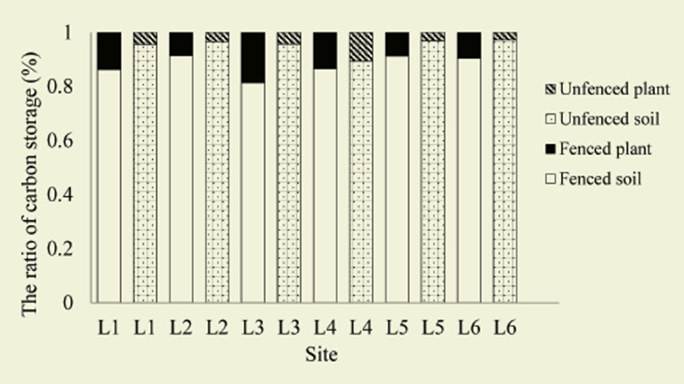
Figure 13: Percentage ratio of carbon storage in the plant versus the soil within each study county in the Liaoning Province, China (L1= Yixian, L2= Lingyuan, L3= Kazuo, L4= Jian chang, L5= Beipiao and L6= Jianping), on fenced or unfenced sites at each of the studied counties. Each histogram is the mean of n=5 Figura 13: Relación porcentual de almacenaje de C en la planta versus el suelo dentro de cada localidad estudiada en la Provincia de Liaoning, China (L1= Yixian, L2= Lingyuan, L3= Kazuo, L4= Jianchang, L5= Beipiao y L6= Jianping), en áreas clausuradas o no al acceso de herbívoros domésticos en cada una de las localidades estudiadas. Cada histograma es el promedio de n=5
The relationship between total plant biomass and total plant C storage
There was a close and positive relation ship (p<0.05) between total plant bio mass and total plant C storage at all of the 6 studied counties on fenced as well as on unfenced areas ( Figure 14).
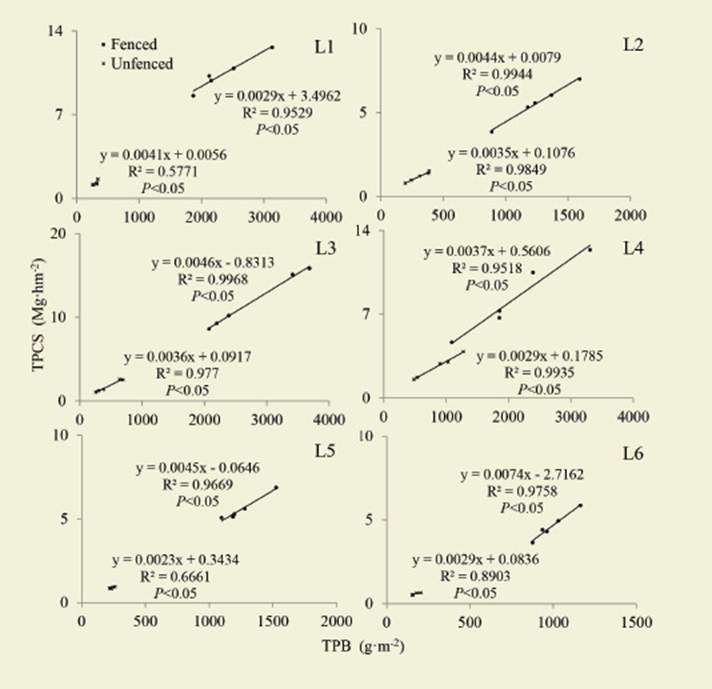
Figure 14: Simple linear regressions between total plant biomass (TPB; g/m 2) and total plant carbon storage (TPCS; Mg/ha) on fenced (black circles) or unfenced sites (black squares) on each of the studied counties in the Liaoning Province, China (L1= Yixian, L2= Lingyuan, L3= Kazuo, L4= Jianchang, L5= Beipiao and L6= Jianping). All symbols are individual data. Figura 14: Regresiones lineales simples entre la biomasa total de las plantas (TPB; g/m 2) y el almacenaje de C en toda la planta (TPCS; Mg/ha) en áreas clausuradas (círculos negros) o no (cuadrados negros) en cada una de las localidades estudiadas en la Provincia de Liaoning, China (L1= Yixian, L2= Lingyuan, L3= Kazuo, L4= Jianchang, L5= Beipiao y L6= Jianping). Todos los símbolos son datos individuales
The R2 between those two variables ranged from 0.5771 (Yixian, unfenced areas) to 0.9968 (Kazuo, fenced areas) among all of the studied relationships.
Discussion
Various studies have determined the ef fects of soil bulk density, soil pH, and total soil N and C concentrations on plant biomass and C storage, and on soil C storage in various grassland eco systems worldwide (e.g., Li et al., 2019). Houlbrooke et al. (1997) reported the detrimental effects of increasing soil bulk density on shoot growth of various rye grass lines. This has been attributed to the detrimental effects of increasing soil bulk density on root and shoot growth, root surface area /g shoot, and penetra tion depth of roots into the soil ( Hall mark & Barber, 1981; Place et al., 2008). Binkly and Vitousek (1989) discussed the importance of soil pH in determin ing the soil nutrient availability for plant roots, and the occurrence and activity of soil microorganisms. They reported that the activity of several soil micro organisms is favoured by more neutral pH conditions in the soil (i.e., closer to 7 on the pH scale), and that the uptake rate for cations seems to be highest in the more neutral pH range. Yang et al. (2009) showed that as total soil N increased, both aboveground and root biomasses increased in Tibetan grasslands. Li et al. (2019) showed that total soil N and organic C contents increased on long-term fenced areas on temperate grass lands in northwest China. In turn, plant functional composition has influenced the rates of soil carbon and nitrogen ac cumulation through time in herbaceous grassland communities ( Fornara & Til man, 2008). Yang et al. (2009) and Li et al. (2019) reported that greater total soil N and organic C contents led to greater plant biomasses and C storage, and also to greater soil organic C storage in var ious old fields in numerous herbaceous grassland communities. In agreement to results of Wang et al. (2014) on grass lands of the Loess Plateau, China, fenced areas had mostly lower soil bulk densi ties, pH values closer to 7, and more N and C soil concentrations than unfenced areas. This may partially contribute to explain the higher values for all studied variables on fenced than unfenced areas in all counties.
We determined a greater root bio mass and C storage in the top soil layer (i.e., 0-10 cm from the soil surface) than deeper in the soil profile in 4 out of the 6 counties. This agrees with findings of Ni et al. (2015) who reported that more root biomass was observed in the top soil layer in various vegetation functional types in karst terrain (i.e., a highly spe cial geomorphology mainly consisting of limestone and dolomite) of southwest ern China.
In general, the highest total abo veground biomass and C storage were obtained in Jianping, and the lowest values for this variable were found in Lingyuan and Beipiao in the fenced ar eas. In these areas, the highest total root biomasses and C storage, however, were reached in Yixian, Kazuo and Jianchang, and the lowest values for these param eters were shown in Lingyuan, Beipiao and Jianping. The greatest total root bio masses and C storages were higher than values found for the total aboveground biomasses and C storages in the fenced areas. Greater biomasses belowground than aboveground have been reported for various authors in different world’s grasslands ( WenHong et al., 2008; Li et al., 2019). As a result, the greatest total plant biomasses and C storages were also reached in Yixian, Kazuo and Jianchang, and the lowest values for this parameter were shown in Lingyuan, Beipiao and Ji anping on the fenced areas. The low total plant biomasses in Beipiao and Jianping might be partially attributed to their lower annual precipitations (Beipiao= 475 mm, Jianping= 531 mm) in compar ison to the other counties (> 560 mm). WenHong et al. (2008) reported that total aboveground and belowground biomasses significantly decreased as annual precipitation also decreased in desert, typical and meadow steppes of Inner Mongolia. In the unfenced areas, however, there were mostly no signifi cant differences among locations for the standing crop and total aboveground biomasses and C storages, and also for the root, total root and total plant bio masses and C storages. Finally, root biomasses and C storages were greater at 0-10 than at 10-20 or 20-30 cm soil depth at four out of the six studied lo cations (Yixian, Kazuo, Jianchiang, and Beipiao for root biomasses, and Yixian, Lingyuan, Kazuo and Jianchang for root carbon storages). WenHong et al. (2008) also found that belowground biomass decreased as soil depth increased in vari ous, different steppes of Inner Mongolia.
In all studied locations, standing crop and total aboveground biomasses and C storages, root, total root and total plant biomasses and C storages were much greater on fenced than unfenced areas. In other studies, fencing has also increased the grassland ecosystem biomass and C storage ( Akiyama & Kawamura, 2007). In the past years, avoiding livestock grazing from the grasslands by estab lishing fences has become a widespread management method for conserving and restoring grassland plants ( Golodest et al., 2010; Chen & Tang, 2016). Generally, fencing increases plant C stor age by increasing plant biomass ( Wang et al., 2014). These findings agree with our study, where fencing increased both plant aboveground and root biomasses. Total plant biomass directly influences the amount of C contained in the vege tation, which will be subsequently incorporated into the soil as litter ( Ni, 2001). There is a buildup of litter in the fenced treatments due to the presence of more grass species, as livestock grazing has been excluded ( Li et al., 2019). More over, long-term fencing can have some changes in soil loosening, soil infiltra tion rates, soil bulk density, soil porosity and increases in oxygen concentrations, which make a change in the soil organic C levels as well ( Li et al., 2019). The de creases of soil bulk density in the fenced areas may be attributed to the fact that trampling may have increased the bulk density in the unfenced but not in the fenced areas. Also, an increase in plant roots and soil microorganisms may have decreased the bulk densities in the fenced areas ( Deng et al., 2014; Aldeza bal et al., 2015). Other studies, however, reported that soil C storage significantly increased with increased grazing pres sure; these increases had a significant positive correlation with the increase of root biomass allocation ( Li et al., 2011).
Although aboveground living plant biomass plays an important role in fix ing C, it is clear from these results that fencing also had a great impact in dra matically increasing root biomass ( Zeng et al., 2017; Li et al., 2019). Fencing in creased twice as much total soil C stor age up to 30 cm soil depth in comparison to unfenced sites. Unfencing has resulted in C losses from this grassland ecosys tem in the past ( Guo et al., 2008). There may be a range of potential mechanisms through which soil C increased in the fenced meadows ( Holt, 1997). Firstly, the return of C from increased aboveground biomass and litter. Secondly, root bio mass is an important component of soil C sequestration. Some researchers have supported that lightly and moderately degraded grasslands can be restored to their initial state within 10-20 years by reducing the grazing intensity and estab lishing fencing ( Li et al., 2013). Howev er, for heavily and extremely degraded grasslands, we should not depend on fencing alone, as other measures will be necessary ( Fang et al., 2010). Similar to the results of Li et al. (2019), our re sults showed that the fenced grasslands had a much higher C storage than the unfenced ones. All these indicate that fencing is an effective restoration meth od, conducive to increasing C storage in grasslands ( Mcsherry & Ritchie, 2013; Chen & Tang, 2016). Silva et al. (2019), however, found that moderate grazing did not reduce aboveground C stocks significantly in various shrub-grassland habitat types in the European Union. Even more, these authors reported that moderate grazing is a management practice that effectively contributes to the conservation of a network of sites in the European Union. These sites were established to halt biodiversity loss and ensure the long-term conservation of threatened species and habitat types. Even more, the effects of grazing inten sity on belowground C cycling should be highlighted since they may need to be incorporated into regional and global models for predicting effects of human disturbance on global grasslands, and as sessing the climate biosphere feedbacks.
Some researchers have confirmed that total plant C storage is often determined by total plant biomass ( Kemper, 2015). Total carbon storage is also important at an organ plant level. For example, when a photosynthetic surface area is not avail able, plant regrowth is dependent from the C stored in plant crowns, stem bases and roots ( Briske & Richards, 1995).
Total plant biomass correlated linearly and positively with total plant C stor age at the studied grassland ecosystems on either fenced or unfenced areas in all counties. This agrees with the results reported by Liao & Boutton (2008). The slopes of the linear regression equations were greater on fenced than unfenced sites in all counties, but Yixian ( Bardgett et al., 1998). These findings indicate that any given change in total plant biomass will cause a greater change in total plant C storage at the fenced than the unfenced areas in all counties, except Yixian. Thus, fencing might contribute to grassland restoration ( Golodets et al., 2010).
Conclusions
Our results confirmed that fencing increased total plant biomass (abo veground + litter + roots), C storage, and total soil C storage in the studied grass lands at the various counties in the Lia oning Province. Fencing proved to be an important management tool for improv ing degraded grasslands in the desertifi cation governance base of the Liaoning province. After fencing was established there was a higher grassland biomass and C storage because of the increase in plant aboveground, root, and litter bio masses.












 uBio
uBio 

